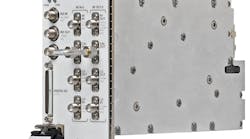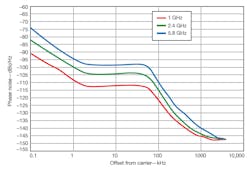Vector signals, with in-phase (I) and quadrature (Q) signal components, are part of modern wireless communications systems employing complex modulation. Testing those systems traditionally called for separate vector signal analyzers (VSAs) and vector signal generators (VSGs). But now, National Instruments (www.ni.com) has introduced its model NI PXIe-5644R vector signal transceiver (VST); a compact PXI Express module, it combines a VSG and VSA with a field-programmable gate array, creating a new form of instrument for wireless communications testing that is both powerful and easy to use. The model NI PXIe-5644R VST features an instantaneous bandwidth of up to 80 MHz, at test frequencies from 65 MHz to 6 GHz.
The NI PXIe-5644R VST (Fig. 1) combines multiple instruments a single three-slot PXI Express module. By mounting multiple NI PXIe-5644R into one PXI Express chassis, a compact test solution can be created for testing wireless systems with multiple-input, multiple-output (MIMO) antenna configurations. The analyzer offers 1-Hz tuning resolution and can process input signals from the average noise level of the receiver section to about 1 W (+30 dBm) input power. The transceiver settles to within 0.1 dB of a final amplitude value in typically 125 μs. At room temperature, the analyzer achieves a typical absolute amplitude accuracy of ±0.50 dB from 65 MHz to 375 MHz, ±0.35 dB from 375 MHz to 2 GHz, ±0.40 dB from 2 to 4 GHz, and ±0.55 dB from 4 to 6 GHz. The analyzer’s frequency response is typically ±1 dB across an 80-MHz bandwidth from 375 MHz to 6 GHz.
The NI PXIe-5644R receiver is based on a homodyne zero-intermediate-frequency (zero-IF) architecture, also known as a direct-downconversion receiver. Input signals are processed through frequency mixers, using local oscillator (LO) signals close in frequency to the input signals, yielding low-frequency (close-to-DC) IF signals. At baseband, the IF signals are separated into I and Q signal components and separately digitized, resulting in I and Q data. These data streams are combined in software to recreate the original signal. Wideband quadrature correction helps achieve high image rejection with minimal LO leakage.
The transmitter section incorporates two I/Q modulators, a filter bank, and additional signal conditioning. The two I/Q modulators, which are optimized for amplitude and phase balance, are the same ones used in the NI PXIe-5673E VSG. A low-phase-noise LO is included on the transmitter path, for connecting multiple upconverters with a single LO source, as might be needed in MIMO applications (Fig. 2).
2. The NI PXIe-5644R is equipped with a low-noise LO that provides low phase noise in the transceivers various bandwidth modes.
Although the analog portions of the NI PXIe-5644R VST are impressive, the role of the FPGA should not be overlooked. It is a Virtex-6 FPGA from Xilinx (www.xilinx.com), which can be readily programmed by means of the LabVIEW FPGA Module within the LabVIEW system software from National Instruments. The FPGA makes use not only of the signals from the NI PXIe-5644R VST’s analyzer and generator, but also of its24 digital input/output (I/Q) lines, which operate at data rates up to 250 Mb/s. The FPGA basecard within the NI PXIe-5644R VST includes the Virtex-6 FPGA, baseband clocking circuitry, 16-bit analog-to-digital converters (ADCs), 16-bit digital-to-analog converters (DACs), programmable digital I/O lines, a PXI Express interface, PXI triggers, and memory.
The NI PXIe-5644R contains a Xilinx Virtex-6 LX195T FPGA, which is used for system configuration, digital data movement, and digital signal processing. The FPGA has direct connections to the ADCs, DACs, PCI Express bus, DRAM, SRAM, PFI 0, digital I/O, and PXI triggers, allowing for custom programming to meet the needs of many types of applications. Multiple clocks are used with the FPGA, including sample clocks at rates of 1X (120 MHz), 2X (240 MHz), and 3X (360 MHz); a 100-MHz clock from the backplane; and free-running 40- and 125-MHz clock oscillators.
The NI PXIe-5644R is available with three different PLL bandwidth options: high, medium, and low. The tradeoff for each is phase noise versus settling time, with the high bandwidth providing the fastest settling time (about 250 μs) but highest phase noise. The low-bandwidth mode is optimized for phase noise, but has settling time of about 1 ms, for applications where tuning speed is not critical. The medium bandwidth offers the best compromise of settling time (about 500 μs) and phase noise, ideal for a wide range of applications.
To help new users get started, a number of LabVIEW sample projects are available for the NI PXIe-5644R, as well as Instrument Design virtual instruments (VIs) that help understand how to program the FPGA for different measurement functions and configurations. The firm has also produced several videos, available on its website, to teach how to use the NI PXIe-5644R.
National Instruments Corp., 11500 N Mopac Expy., Austin, TX 78759-3504; (512) 683-0100, www.ni.com.

